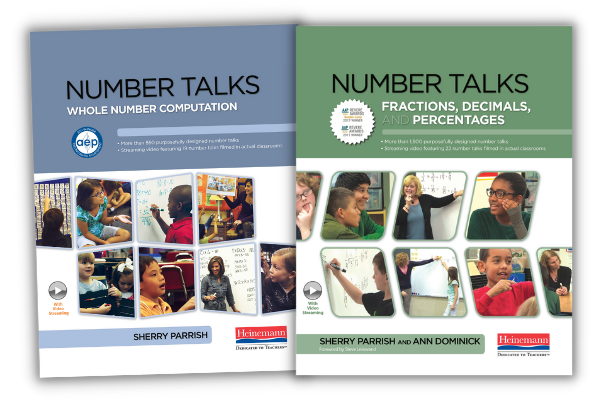
Number talks create confident student problem solvers
Classrooms (at all grade levels) are filled with students and teachers who think of mathematics as primarily rules and procedures to memorize. This often happens without understanding the numerical relationships that provide the foundation for these rules.
At times, the teaching of mathematics has focused on speed and accuracy without understanding the mathematical logic behind an idea or answer. For some people, thinking about math as strictly procedural has been successful. But for many of us, memorizing a set of rules has not led to greater mathematical confidence in our daily lives.
Number talks are a great way for teachers to help students share their mathematical thinking and grow their confidence as mathematicians.
Number talks are needed now more than ever
While a procedure-based version of math teaching may have seemed to work in the past, students today must develop a deeper understanding of mathematics.
Today, students must learn to:
- reason numerically
- develop number sense
- evaluate the reasonableness of an answer
Students must choose strategies that are applicable to specific situations and figure out whether an answer makes sense. They also need to engage in math conversations and communicate their ideas about their solutions.
Number talks develop efficient, flexible, and accurate problem solvers
Today’s math teachers must focus on preparing students to be mathematically proficient and solve problems accurately, efficiently, and flexibly.
The introduction of number talks is a pivotal vehicle for developing strategies that build upon the key foundational ideas of mathematics such as:
- composition and decomposition of numbers
- our system of tens
- properties of numbers
Conversations around purposefully crafted number problems are at the very core of number talks. These are opportunities for the class to come together to share their mathematical thinking.
Number talks are purposefully designed
The problems in number talks are designed to elicit specific strategies that focus on number relationships and number theory.
Students are presented with problems in either a whole- or small-group setting and are expected to learn to mentally solve them accurately, efficiently, and flexibly. By sharing and defending their solutions and strategies, students are provided with opportunities to collectively reason about numbers while building connections to key conceptual ideas in mathematics.
Professional Learning in Support of Professional Books Number Talks are five- to fifteen-minute classroom conversations around purposefully crafted computation problems solved mentally. As students communicate mathematical thinking, they develop efficient, flexible, and accurate computation strategies that build upon the key foundational ideas of mathematics.
|
What do number talks look like?
A typical number talk can be conducted in 5-15 minutes. During these conversations, students learn how to visualize problems, perform calculations quickly, and flexibly access mathematical strategies.
Number talks are a great way for teachers to begin a math lesson, supplement math instruction in small groups, or provide targeted intervention for students who struggle with math.
You can find a comprehensive view of number talks in either Number Talks: Whole Number of Computation or Number Talks: Fractions, Decimals, and Percentages. Both resources provide already-designed number talks and extensive video collections that share number talk conversations with students at different grade levels.
5 key components of number talks
There are several key components to teaching with numbers talks:
- Classroom environment and community
- Classroom discussions
- The teacher's role
- The role of mental math
- Purposeful computation problems
1. Classroom environment and community
Building a cohesive classroom community is essential for creating a safe, risk-free environment for effective number talks. Students should be comfortable in offering ideas for discussion, questioning themselves and their peers, and investigating new thinking and strategies. The culture of the classroom should be one of acceptance based on a common quest for learning and understanding.
It takes time to establish a community of learners built on mutual respect, but if teachers consistently set this expectation from the beginning of the year, students will respond.
2. Classroom discussions
During a number talk, the teacher writes a problem on the board and gives the students time to solve it mentally.
Once students have found an answer, they are encouraged to continue finding efficient strategies while others are thinking. All answers—correct and incorrect—are recorded on the board for students to consider.
Do students come up with incorrect answers in number talks? Of course.
However, students at every grade level are asked to defend or justify their answers to prove their thinking to their peers. In number talk classrooms, students have a sense of shared authority in determining whether an answer is accurate. The teacher is not the ultimate authority—students are expected to think carefully about the solutions and thinking presented.
3. The teacher's role
As educators, we are accustomed to assuming the roles of telling and explaining. Teaching by telling is the method most of us experienced as students, and many continue to emulate this model in their own practice—especially in math.
A goal of number talks is to help students develop understanding by building upon the mathematical thinking shared during class conversations. Therefore, the teacher's role must shift from being the sole authority in imparting information and confirming correct answers to being a facilitator, questioner, listener, and learner.
Keeping the discussion focused on important mathematics and helping students learn to structure their ideas and wonderings during a number talk is essential to ensure that the conversation flows in a meaningful and natural manner. As a facilitator, you must guide the students to share and discuss examples that build upon your purposes. By posing such questions as “How does Juan’s strategy connect to the ideas in Renee’s strategy?” you are leading the conversation to build on meaningful mathematics.
4. The role of mental math
No matter the grade level, mental computation is a key component of number talks because it encourages students to build on number relationships to solve problems instead of relying only on memorized procedures.
One purpose of number talks is for the students to focus on number relationships and use these relationships to develop efficient, flexible strategies with accuracy. When students approach problems without paper and pencil, they are encouraged to rely on what they know and understand about the numbers and how they are interrelated. Mental computation causes them to be efficient with the numbers to avoid holding numerous quantities in their heads.
5. Purposeful computation problems
Crafting problems that guide students to have conversations about mathematical relationships is an essential part of number talks. This kind of thinking is used to build mathematical understanding and knowledge.
The teacher’s goals and purposes for number talks should determine the numbers and operations that are chosen. Careful planning before a number talk is necessary to design “just right” problems for students.
Number talks help students now and throughout their lives
We live in a world of numbers, and students at every grade need to become comfortable with them. Number talks are a teaching routine that helps guide students in this way.
If they can learn to use numbers effectively, they will be able to solve problems in a variety of ways, think critically about the information they are given, and explain their thinking in math conversations. Number talks help them develop skills and strategies that will serve them throughout life.

Sherry Parrish is best described as “a teacher of teachers.” With over 35 years in the field of education, Sherry’s experiences as a classroom educator, university professor, and national and international speaker focus on teaching and learning mathematics through inquiry. A recipient of the Presidential Award for Excellence in Mathematics Teaching, Dr. Parrish is an advocate of students constructing their own mathematical relationships. Sherry is the author of the AEP Distinguished Achievement award winning book, Number Talks: Whole Number Computation and the AEP Golden Lamp winner, Number Talks: Fractions, Decimals, and Percentages.
Ann Dominick received her undergraduate degree in education from Auburn University, a Master’s in Education from the University of Alabama at Birmingham, a doctorate from Vanderbilt University, and a Certificate of Advanced Studies in Curriculum and Instruction at Harvard University. She was awarded the National Science Foundation’s Presidential Award for Excellence in Teaching Elementary Mathematics and is a former Alabama State Teacher of the Year. She is currently an Assistant Professor at Birmingham-Southern College teaching mathematics education courses and working with pre-service and in-service teachers.
 Number Talks: Whole Number Computation (Grades K–5, K–2, 3–5) supports teachers with implementing and facilitating number talks as a daily routine, empowering students to develop numerical reasoning with whole numbers.
Number Talks: Whole Number Computation (Grades K–5, K–2, 3–5) supports teachers with implementing and facilitating number talks as a daily routine, empowering students to develop numerical reasoning with whole numbers. Number Talks: Fractions, Decimals, and Percentages (Grades 3–5) supports teachers to implement Number Talks as a daily routine that empowers students to develop numerical reasoning with fractions, decimals, and percentages.
Number Talks: Fractions, Decimals, and Percentages (Grades 3–5) supports teachers to implement Number Talks as a daily routine that empowers students to develop numerical reasoning with fractions, decimals, and percentages.

